NEW ORLEANS #1 TOURIST ATTRACTION: THE NATIONAL WORLD WAR II MUSEUM
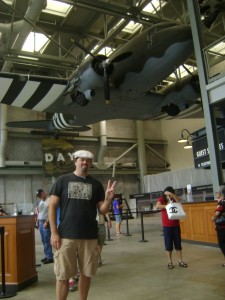 As a history buff that has read a good deal about World War II including several books by local legend Stephen Ambrose (you’ve probably heard of Band of Brothers), I have been anticipating a trip to The National World War II Museum since moving to New Orleans. July 4th weekend had me feeling patriotic so the following Monday a friend and I wandered over to the Central Business District (or ‘American Sector’ as it was known when Canal was a sharp diving line between Creoles and Americans) to visit what was recently recognized as the top New Orleans Tourist Attraction.
As a history buff that has read a good deal about World War II including several books by local legend Stephen Ambrose (you’ve probably heard of Band of Brothers), I have been anticipating a trip to The National World War II Museum since moving to New Orleans. July 4th weekend had me feeling patriotic so the following Monday a friend and I wandered over to the Central Business District (or ‘American Sector’ as it was known when Canal was a sharp diving line between Creoles and Americans) to visit what was recently recognized as the top New Orleans Tourist Attraction.
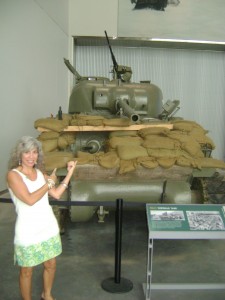 Trip Advisor ranks The National World War II Museum as the #1 New Orleans Tourist Attraction and the #7 museum in the U.S. I’d have a tough time taking exception. The compound stretches over several building between Magazine and St. Charles just before the overpass at Calliope and plans are underway for it to continue to grow. Be sure to allow yourself a day if not two. I could easily spend a week in there and considering the American Sector Restaurant is run by legendary chef John Besh and boasts ‘The Best Happy Hour In New Orleans’ I would be well and affordably fed. I would also be well entertained—The Stage Door Canteen is a dinner theater that features thematic performances and every Sunday the museum hosts swing dances with free lesson.
Trip Advisor ranks The National World War II Museum as the #1 New Orleans Tourist Attraction and the #7 museum in the U.S. I’d have a tough time taking exception. The compound stretches over several building between Magazine and St. Charles just before the overpass at Calliope and plans are underway for it to continue to grow. Be sure to allow yourself a day if not two. I could easily spend a week in there and considering the American Sector Restaurant is run by legendary chef John Besh and boasts ‘The Best Happy Hour In New Orleans’ I would be well and affordably fed. I would also be well entertained—The Stage Door Canteen is a dinner theater that features thematic performances and every Sunday the museum hosts swing dances with free lesson.
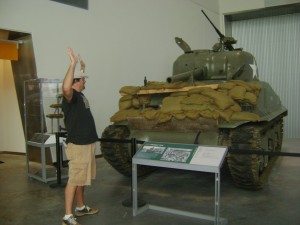 Admission is $22, but that will increase if you agree to the strongly suggested upgrades. The two major add-ons ($5 each) are the 45 minute ‘4-D’ movie narrated by Tom Hanks, Beyond All Boundaries, and a motion simulating submarine experience, The Final Mission. Correctly guessing that the museum itself would be more than we could handle, we paid for only the film. It was starting in just an hour so the ticket taker suggested we exit the main exhibit and start across the street at the newly opened U.S. Freedom Pavilion: The Boeing Center.
Admission is $22, but that will increase if you agree to the strongly suggested upgrades. The two major add-ons ($5 each) are the 45 minute ‘4-D’ movie narrated by Tom Hanks, Beyond All Boundaries, and a motion simulating submarine experience, The Final Mission. Correctly guessing that the museum itself would be more than we could handle, we paid for only the film. It was starting in just an hour so the ticket taker suggested we exit the main exhibit and start across the street at the newly opened U.S. Freedom Pavilion: The Boeing Center.
U.S. FREEDOM PAVILON: THE BOEING CENTER—HISTORY & TECHNOLOGY AT ITS BEST
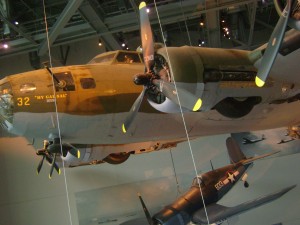 The effect upon walking into this impressive new structure is instantly stunning. The ceiling, four or five stories high, supports six actual World War II aircraft suspended from the rafters in flight as if in a dogfight, including a giant B-17. Glass windows extend to the roof on outside wall and add to the open-air feel. I immediately set upon the curator with questions and he proudly pointed out that this room has the most suspended aircraft of any display in the world. With a twinkle in his eye he said the Smithsonian had (I believe) only two.
The effect upon walking into this impressive new structure is instantly stunning. The ceiling, four or five stories high, supports six actual World War II aircraft suspended from the rafters in flight as if in a dogfight, including a giant B-17. Glass windows extend to the roof on outside wall and add to the open-air feel. I immediately set upon the curator with questions and he proudly pointed out that this room has the most suspended aircraft of any display in the world. With a twinkle in his eye he said the Smithsonian had (I believe) only two.
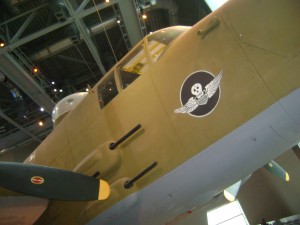 A tank, a jeep, and several displays filled the floor and a couple of looping films detailing the history of aircraft production during the war lined the walls. Stairs at the back of the room led to suspended bridges on two additional levels that allowed you view the aircraft at multiple angles. The first of the these two levels included booths where you could choose from about twenty short recorded oral histories collected from actual participants. You could lose a couple of hours here alone. More enticing, though, was the interactive war map in the center of the floor that looked like a high tech gadget you’d find in the Pentagon.
A tank, a jeep, and several displays filled the floor and a couple of looping films detailing the history of aircraft production during the war lined the walls. Stairs at the back of the room led to suspended bridges on two additional levels that allowed you view the aircraft at multiple angles. The first of the these two levels included booths where you could choose from about twenty short recorded oral histories collected from actual participants. You could lose a couple of hours here alone. More enticing, though, was the interactive war map in the center of the floor that looked like a high tech gadget you’d find in the Pentagon.
ABOVE: VIDEO FOOTAGE OF THE BATTLE OF IWO JIMA

This interactive world map was on a flat screen of table height and proportions and pinpointed the site of every major campaign of the war, both European and Pacific. When you selected a battle on the touch screen, an interactive menu appeared. The primary feature was a localized map with animated symbols illustrating troop and/or ship movements. By following the prompts, it would walk you through the strategy and execution step-by-step. Other menus accessed additional features sucah as detailed description of weaponry used in the campaign, which branches in the service participated, and archives of actual video footage clips from the battle. I felt like Tom Cruise in Minority Report, opening, closing, and shuffling about screens. I could have spent days here. This is one of the best tools for conveying a deeper understanding history I’ve ever seen—technology at its idealized best. Screw an X-box. I want one of these in my living room!
ABOVE: INTERACTIVE EXHIBIT ON THE BATTLE OF MIDWAY
BEYOND ALL BOUNDARIES: A ‘UNIVERSAL’ EXPERIENCE
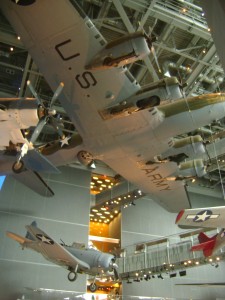 I was so entranced by the map—barely making it through Midway and Iwo Jima—that I was late for the movie, arriving just at the start of the pre-movie in a standing room outside the theater ala major them park rides. Once the brief introductory film was over, we were ushered into a large theater with rows of comfortably cushioned chairs.
I was so entranced by the map—barely making it through Midway and Iwo Jima—that I was late for the movie, arriving just at the start of the pre-movie in a standing room outside the theater ala major them park rides. Once the brief introductory film was over, we were ushered into a large theater with rows of comfortably cushioned chairs.
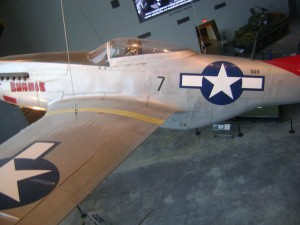 As the main feature rolled, the ‘4-D’ enhancements of set pieces rising from the floor or descending from the ceiling reminded me of The Terminator ‘ride’ at Universal Studios. The chairs vibrated at key moments during battle footage and it began snowing in the theater during The Battle of the Bulge. Still, it was tastefully done and never overwhelmed or demeaned the stark subject matter. Condensing something so complex into 45 minutes is no easy feat, but the creators an admirable job. I was visibly moved by the time it ended and my friend was in tears.
As the main feature rolled, the ‘4-D’ enhancements of set pieces rising from the floor or descending from the ceiling reminded me of The Terminator ‘ride’ at Universal Studios. The chairs vibrated at key moments during battle footage and it began snowing in the theater during The Battle of the Bulge. Still, it was tastefully done and never overwhelmed or demeaned the stark subject matter. Condensing something so complex into 45 minutes is no easy feat, but the creators an admirable job. I was visibly moved by the time it ended and my friend was in tears.
AMERI-CENTRISM: A PUZZLE MISSING PIECES
 If I had one complaint about the film and museum in general it was how America-centric it was. I get that it’s our national museum, yet it was much more than just our war and, except Pearl Harbor, none of it was fought on our soil. We already tend to be an isolationist country with limited perspective on world events, so this narrow focus on how ‘we’ won the war feeds into this shortsightedness. For example, the terms Utah Beach and Omaha Beach are deeply imbedded in our vernacular, but the sacrifice was just as painful and important for British and Canadian troops on Sword Beach, Gold Beach, and Juno Beach. Winning was an Allied effort, yet brushing over the contribution of our allies impedes a greater understanding of the conflict and diminishes the sacrifice made by citizens of many nations, including ours, who fought and died side by side. Again, I get that it’s our museum and that’s where the focus should be. Still, at times it felt like a broader view was missing. America didn’t win the war. The Allies did.
If I had one complaint about the film and museum in general it was how America-centric it was. I get that it’s our national museum, yet it was much more than just our war and, except Pearl Harbor, none of it was fought on our soil. We already tend to be an isolationist country with limited perspective on world events, so this narrow focus on how ‘we’ won the war feeds into this shortsightedness. For example, the terms Utah Beach and Omaha Beach are deeply imbedded in our vernacular, but the sacrifice was just as painful and important for British and Canadian troops on Sword Beach, Gold Beach, and Juno Beach. Winning was an Allied effort, yet brushing over the contribution of our allies impedes a greater understanding of the conflict and diminishes the sacrifice made by citizens of many nations, including ours, who fought and died side by side. Again, I get that it’s our museum and that’s where the focus should be. Still, at times it felt like a broader view was missing. America didn’t win the war. The Allies did.
THE WAR IN EUROPE: A MULTI-MEDIA BLITZKRIEG
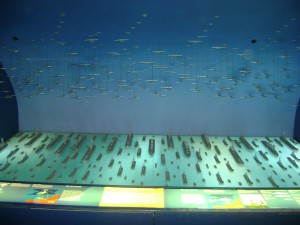 After the film, we headed into the museum proper where they first tell the story of the European Theater through every medium imaginable: Films, interactive maps, artifacts, recorded oral histories, diagrams, models, etc. Two of the most stirring exhibits were models that brilliantly illuminated dry facts and figures that the brain can’t fully digest upon mere mention. To drive home how outmanned the U.S. was at the start of the wall, a display of toy soldiers, each representing 1000 soldiers, illustrated how paltry U.S. forces were compared to German and Japanese. These unnerving little toy soldiers drove home the point in a way mere numbers never could. Later, a the D-Day displayed one-for-one toy models to help visitors visualize the actual number of ships on the sea and the aircraft in the air tthat morning. This rendering of such a mighty force was both thrilling and frightening.
After the film, we headed into the museum proper where they first tell the story of the European Theater through every medium imaginable: Films, interactive maps, artifacts, recorded oral histories, diagrams, models, etc. Two of the most stirring exhibits were models that brilliantly illuminated dry facts and figures that the brain can’t fully digest upon mere mention. To drive home how outmanned the U.S. was at the start of the wall, a display of toy soldiers, each representing 1000 soldiers, illustrated how paltry U.S. forces were compared to German and Japanese. These unnerving little toy soldiers drove home the point in a way mere numbers never could. Later, a the D-Day displayed one-for-one toy models to help visitors visualize the actual number of ships on the sea and the aircraft in the air tthat morning. This rendering of such a mighty force was both thrilling and frightening.
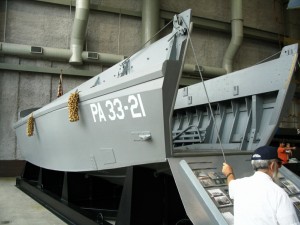 Another highlight of the European exhibits was a room dedicated to the Higgins boat. Technically known as the LCPV (Landing Craft, Vehicle, Personnel) this flat bottom boat that was used to storm the beaches of Normandy, North Africa, and throughout the Pacific is credited by Eisenhower himself with winning the war. The Higgins boat was engineered and manufactured in New Orleans, thus the site selection for this archive. Andrew Higgins was a local boat manufacturer who designed his flat bottomed boats so that local trappers and oil workers (and perhaps smugglers during prohibition) could navigate the shallow bayous of Louisiana. Despite seeming now synonymous with the war, the military initially resisted Higgins’s proposals to convert his boats into the military transports seen in the opening of Saving Private Ryan running onto the beach to deposit troops and tanks. Higgins was persistent, though, and the military finally listened. Afterward, Eisenhower referred to him as “the man who won the war for us,” having changed the history of naval warfare by allowing the Allies to invade land without capturing heavily defended ports.
Another highlight of the European exhibits was a room dedicated to the Higgins boat. Technically known as the LCPV (Landing Craft, Vehicle, Personnel) this flat bottom boat that was used to storm the beaches of Normandy, North Africa, and throughout the Pacific is credited by Eisenhower himself with winning the war. The Higgins boat was engineered and manufactured in New Orleans, thus the site selection for this archive. Andrew Higgins was a local boat manufacturer who designed his flat bottomed boats so that local trappers and oil workers (and perhaps smugglers during prohibition) could navigate the shallow bayous of Louisiana. Despite seeming now synonymous with the war, the military initially resisted Higgins’s proposals to convert his boats into the military transports seen in the opening of Saving Private Ryan running onto the beach to deposit troops and tanks. Higgins was persistent, though, and the military finally listened. Afterward, Eisenhower referred to him as “the man who won the war for us,” having changed the history of naval warfare by allowing the Allies to invade land without capturing heavily defended ports.
WAR IN THE PACIFIC: A BRUTAL MISCALCULATION
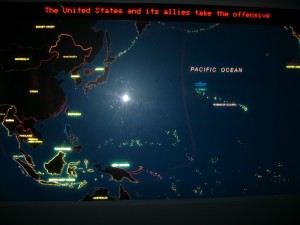 Even though I know a good bit about the war, the European exhibit provided an overwhelming amount of information, and thus this museum suffers from the same fault that nearly all coverage of the war does. The European Theatre almost always gets first treatment and the Pacific Theater gets overshadowed. Don’t get me wrong—just as much care was put into this section, but by the time I got there the museum was closing in an hour and my brain was closing sooner. I’m sure more people than not are similarly overwhelmed and skim through the back half. Nevertheless, I felt guilty for miscalculating my time so did the best I could to give the resisistance to this brutal miscalculation by the Japanese the attention it deserved.
Even though I know a good bit about the war, the European exhibit provided an overwhelming amount of information, and thus this museum suffers from the same fault that nearly all coverage of the war does. The European Theatre almost always gets first treatment and the Pacific Theater gets overshadowed. Don’t get me wrong—just as much care was put into this section, but by the time I got there the museum was closing in an hour and my brain was closing sooner. I’m sure more people than not are similarly overwhelmed and skim through the back half. Nevertheless, I felt guilty for miscalculating my time so did the best I could to give the resisistance to this brutal miscalculation by the Japanese the attention it deserved.
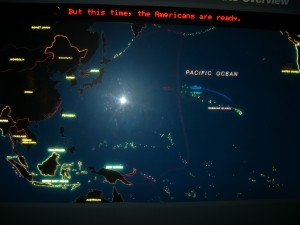 Although often treated as an afterthought, the war in the Pacific was every bit if not more brutal than the war in Europe. Hitler gets all the pub, but the accounts of the atrocities and brutality performed by Japanese troop are enough to turn a strong man’s stomach. In her excellent book Unbroken, Laura Hillenbrand gives the statistics for POW survival in Europe compared to the Pacific. I forget the exact stats, but I it was something like over 90% survival in Europe and around 10-20% in Japanese interment.
Although often treated as an afterthought, the war in the Pacific was every bit if not more brutal than the war in Europe. Hitler gets all the pub, but the accounts of the atrocities and brutality performed by Japanese troop are enough to turn a strong man’s stomach. In her excellent book Unbroken, Laura Hillenbrand gives the statistics for POW survival in Europe compared to the Pacific. I forget the exact stats, but I it was something like over 90% survival in Europe and around 10-20% in Japanese interment.
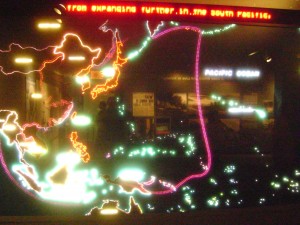 At the entrance to this exhibit, a lighted map with voice over provides an excellent explanation of the more confusing Pacific strategy (island hopping is much less linear than a direct march to Berlin). Another highlight came at the end through the detailed depiction of the development and dispatch of the Atomic Bomb. When I return, I’ll start in the Pacific and backtrack.
At the entrance to this exhibit, a lighted map with voice over provides an excellent explanation of the more confusing Pacific strategy (island hopping is much less linear than a direct march to Berlin). Another highlight came at the end through the detailed depiction of the development and dispatch of the Atomic Bomb. When I return, I’ll start in the Pacific and backtrack.
THE AMERICAN SECTOR: CHOW WORTHY OF ENSHRINMENT
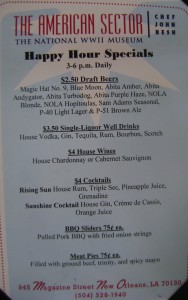 I hadn’t eaten since breakfast so I was starved by the time I exited the museum around five o’clock. My friend had already retreated to the bar and was texting me to rave about the specials. During happy hour all beers are $2.50 and pork sliders and meat pies are 75¢. This definitely lives up to its boast as ‘The Best Happy Hour in New Orleans.’ The beer selection was solid and the food tasty, especially for the price. I’ll definitely seek out the bar even when not visiting The National World War II Museum.
I hadn’t eaten since breakfast so I was starved by the time I exited the museum around five o’clock. My friend had already retreated to the bar and was texting me to rave about the specials. During happy hour all beers are $2.50 and pork sliders and meat pies are 75¢. This definitely lives up to its boast as ‘The Best Happy Hour in New Orleans.’ The beer selection was solid and the food tasty, especially for the price. I’ll definitely seek out the bar even when not visiting The National World War II Museum.
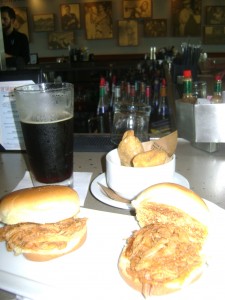 But I’ll be back for the exhibits too. Five hours wasn’t enough. If planning a visit, I’d advise arriving when they open at 9:00 and taking a leisurely lunch to rest your aching feet and reeling brain. Although most visits to this city are pleasure seeking pursuits, The National World War II Museum proudly stands out as one of the top New Orleans Attractions and it’s definitely worth the change of pace. Come for the history and stay for lunch or dinner with John Besh.
But I’ll be back for the exhibits too. Five hours wasn’t enough. If planning a visit, I’d advise arriving when they open at 9:00 and taking a leisurely lunch to rest your aching feet and reeling brain. Although most visits to this city are pleasure seeking pursuits, The National World War II Museum proudly stands out as one of the top New Orleans Attractions and it’s definitely worth the change of pace. Come for the history and stay for lunch or dinner with John Besh.
[…] so I was a little more hesitant in visiting compared to my unabashed excitement at seeing the National World War II Museum. MGW’s media and publicity director, however, was kind enough to respond to my inquiry so I […]